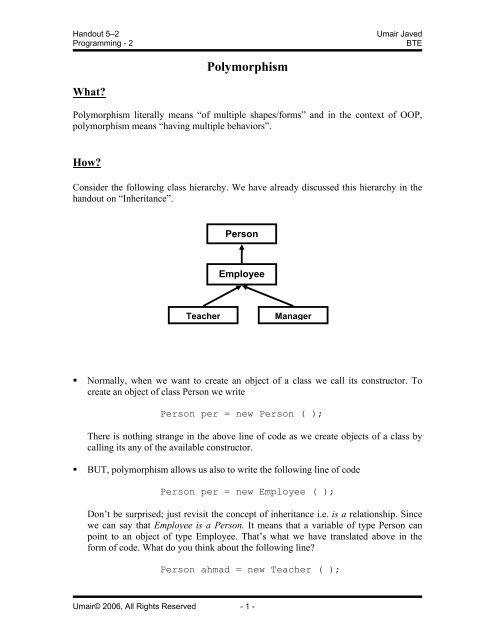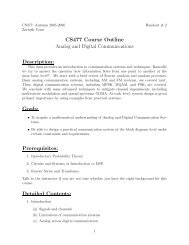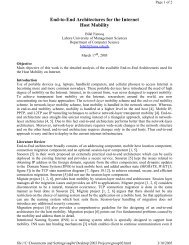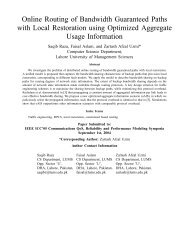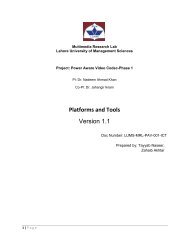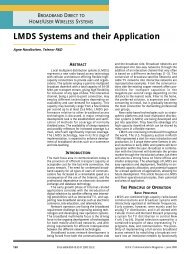Polymorphism - Suraj @ LUMS
Polymorphism - Suraj @ LUMS
Polymorphism - Suraj @ LUMS
You also want an ePaper? Increase the reach of your titles
YUMPU automatically turns print PDFs into web optimized ePapers that Google loves.
Handout 5–2 Umair Javed<br />
Programming - 2 BTE<br />
What?<br />
<strong>Polymorphism</strong><br />
<strong>Polymorphism</strong> literally means “of multiple shapes/forms” and in the context of OOP,<br />
polymorphism means “having multiple behaviors”.<br />
How?<br />
Consider the following class hierarchy. We have already discussed this hierarchy in the<br />
handout on “Inheritance”.<br />
Person<br />
Employee<br />
Teacher Manager<br />
Normally, when we want to create an object of a class we call its constructor. To<br />
create an object of class Person we write<br />
Person per = new Person ( );<br />
There is nothing strange in the above line of code as we create objects of a class by<br />
calling its any of the available constructor.<br />
BUT, polymorphism allows us also to write the following line of code<br />
Person per = new Employee ( );<br />
Don’t be surprised; just revisit the concept of inheritance i.e. is a relationship. Since<br />
we can say that Employee is a Person. It means that a variable of type Person can<br />
point to an object of type Employee. That’s what we have translated above in the<br />
form of code. What do you think about the following line?<br />
Person ahmad = new Teacher ( );<br />
Umair© 2006, All Rights Reserved - 1 -
Handout 5–2 Umair Javed<br />
Programming - 2 BTE<br />
Employee usman = new Manager ( );<br />
These are 100 percent correct and rightly so, because Teacher is a Person as well as<br />
Manager is an Employee.<br />
Note: The reversal of the above is not necessarily to be true. For example, Person is not<br />
necessarily a Teacher. As according to the above given hierarchy, Person can be<br />
either an Employee or Person can be a Teacher or a Manger.<br />
Rule of thumb<br />
Since a child class object is also an object of its parent class therefore it can be<br />
pointed by a reference of parent class. Or in other words “A parent class reference<br />
variable can be used to point any objects of its descendants (subclasses)”.<br />
Understanding <strong>Polymorphism</strong><br />
Just cast a glance over the hierarchy given above so that we can completely<br />
understand the concept of polymorphism.<br />
From the hierarchy, we came to know that Person is a (direct) superclass of Employee<br />
and also Person is a (indirect) superclass of Teacher as well as of Manager.<br />
Hence, by bearing in mind is a relationship, we can say that Employee is a Person or<br />
Teacher is a Person or Manager is a Person.<br />
Or we can say that Person can take the form of Employee, Person can take the form<br />
of Teacher and Person can take the form of Manager. (Remember that polymorphism<br />
means “of multiple forms”).<br />
Polymorphic Methods<br />
Happily, there is no new concept under this title. In fact, overridden methods are so called<br />
polymorphic (“having different behavior”).<br />
Just think a while, why we need method overriding? Of course, overriding allows the<br />
subclass to modify the behavior (method) of the superclass as needed. This indicates that<br />
a method in subclass will have a different behavior from the one in the superclass.<br />
Umair© 2006, All Rights Reserved - 2 -
Handout 5–2 Umair Javed<br />
Programming - 2 BTE<br />
Point to Remember<br />
A polymorphic method results in different actions (behaviors) depending on the<br />
object being referenced. This phenomenon often referred as late binding or run-time<br />
binding.<br />
This has been explained in the following example:<br />
<strong>Polymorphism</strong> Example<br />
The Test.java class uses the instances of class Employee and Teacher. We have<br />
already defined these classes in the handout on “Inheritance”. These classes are used in<br />
this example without any modification.<br />
Instructions<br />
Modify the file Test.java of inheritance example, one we defined in the handout<br />
on “Inheritance”.<br />
Write the following lines of code inside Test.java.<br />
Make sure that Employee and Teacher classes are available in the current<br />
directory you are working in to run the Test class.<br />
Code<br />
The Test class acts as a driver class as it contains the main method. Objects of Employee<br />
& Teacher class are created inside main and calls are made to display and toString<br />
method using these objects.<br />
class Test{<br />
public static void main (String args[]){<br />
// Make employee references<br />
Employee ref1, ref2;<br />
ref1 = new Employee(89, "khurram ahmad");<br />
// is-a relationship, polymorphism<br />
ref2 = new Teacher (91, "ali raza", "phd");<br />
ref1.display(); //call to Employee class display method<br />
ref2.display(); //call to Teacher class display method<br />
Umair© 2006, All Rights Reserved - 3 -
Handout 5–2 Umair Javed<br />
Programming - 2 BTE<br />
System.out.println("Employee: " +ref1.toString());<br />
System.out.println("Teacher: " + ref2.toString());<br />
} //end of main<br />
}//end class<br />
Understanding Run-Time Binding<br />
In the above code example, two Employee class references namely ref1 & ref2 are<br />
created. An Employee object is assigned to ref1 & Teacher object is assigned to ref2<br />
(polymorphism). This is shown in the example code as<br />
ref2 = new Teacher (91, “ali raza”, “phd” );<br />
Now, take next line of code, i.e.<br />
ref1.display ( );<br />
It will make call to display method of Employee class. But the next line of code contains<br />
the real interesting part.<br />
ref2.display ( );<br />
Apparently, it seems that it will also make a call to the display method of Employee class<br />
object, but this does not happen. Actually, it makes call to display method of Teacher<br />
class. Let’s closely examine what is happening behind the scenes?<br />
When we compile our Test class using javac command, the compiler will ensure that<br />
display method should exist in the Employee class. On execution of Test program, java<br />
will check that ref2 is pointing to which class’s object? In our case, it is pointing to<br />
Teacher class that’s why it will call the display method of Teacher class.<br />
As all this has happened at the run time or at the execution time of the program, for this<br />
reason it is called run time binding or late binding.<br />
Umair© 2006, All Rights Reserved - 4 -
Handout 5–2 Umair Javed<br />
Programming - 2 BTE<br />
Type Casting<br />
Java is a strongly typed language. You cannot declare a variable or a reference of a class<br />
without specifying its type. Sometime there is a requirement to convert (cast) one data<br />
type into another. There are two types of casting: UpCasting & DownCasting. While<br />
casting, following points should be kept in mind<br />
UpCasting<br />
In upcasting we convert a smaller datatype into a larger datatypes. Since converting a<br />
smaller dataytype into a larger datatype does not cause any information loss therefore<br />
upcasting is implicit (i.e. it occurs automatically and we do not have to write any extra<br />
piece of code)<br />
DownCasting<br />
In downcasting we convert a larger datatype into a smaller datatype. Since converting a<br />
larger dataytype into a smaller datatype may cause an information loss therefore<br />
downcasting is explicit (i.e. it does not occur automatically and we have to tell compiler<br />
that we want to downcast otherwise it won’t let us compile the code)<br />
Upcasting and Downcasting in Primitives<br />
In primitive datatypes such as int, float, double upcasting occurs when we convert a<br />
smaller data type (in terms of size (bytes)) into a large data type. For example; converting<br />
int (4 bytes) to long (8 bytes) or float (4 bytes) to double(8 bytes). This has been shown<br />
in the following code fragment.<br />
int i = 4;<br />
double d ;<br />
d = i;<br />
Since double is a bigger type, conversion is automatic but when we convert from double<br />
to int there can be a loss of information and therefore explicit casting is required (i,e, we<br />
are telling the compiler that we know what we are going to do, so do it.)<br />
double d = 4;<br />
int i ;<br />
i =(int)d;<br />
Explicit typecasting of double into an integer<br />
Umair© 2006, All Rights Reserved - 5 -
Handout 5–2 Umair Javed<br />
Programming - 2 BTE<br />
Upcasting and downcasting in Objects<br />
Person<br />
Employee<br />
Often students find it hard to understand the concept of upcasting in classes. They think<br />
that since Teacher class is a child of Employee so it should contain more variables then<br />
Employee (due to inheritance, its own + that of Employee) and therefore objects of<br />
Teacher class need more memory and hence Teacher is a larger Datatype.<br />
This concept is wrong, a simple rule of thumb is that a class that is higher in the hierarchy<br />
is a larger class so you can implicitly upcast your child objects to parent class type. Here<br />
Employee class is a bigger class then Teacher or Manager class, similarly Person is larger<br />
class then all of Employee, Teacher or Manager. To understand why, from inheritance we<br />
know that every teacher is an employee and every manager is also an employee, it means<br />
that Employee class has more objects than either of Teacher or Manager (It contains its<br />
own objects + objects of Teacher + objects of Manager), which shows that Employee is a<br />
larger class/datatype and upcasting to larger datatype is implicit. Also another view could<br />
be that since Teacher and Manager are Employee (due to inheritance) hence a variable<br />
declared of type Employee can point to objects of type Teacher or Manager<br />
Employee e ;<br />
Teacher t = new Teacher()<br />
e = t ;<br />
Here ‘e’ is of type Employee and ‘t’ is of type Teacher and ‘t’ is also pointing to a<br />
teacher object since Teacher is an Employee (due to inheritance) therefore ‘e’ can point<br />
to object pointed by ‘t’. Don’t need to do anything implicit /upcasting takes place<br />
However converting from Teacher to Employee won’t be possible without explicit<br />
casting e.g<br />
Employee e = new Teacher() ;<br />
Teacher t;<br />
t = (Teacher)e ;<br />
Umair© 2006, All Rights Reserved - 6 -<br />
Teacher Manager
Handout 5–2 Umair Javed<br />
Programming - 2 BTE<br />
Here though ‘e’ is pointing to a teacher object but still we can not assign it to ‘t’ without<br />
explicit downcast because Teacher is a smaller data type. Also since ‘e’ can point to<br />
Employee object as well as Teacher object as well as Manager object so it would not be<br />
possible for the compiler to tell in which type we want to cast ‘e’ hence we have told the<br />
compiler explicitly here that we want to convert the object pointed by ‘e’ to Teacher<br />
datatype. Had it been a wrong cast, for example suppose instead of pointing to a Teacher<br />
object ‘e’ is pointing to a Manager object then it would have caused the exception.<br />
Umair© 2006, All Rights Reserved - 7 -
Handout 5–2 Umair Javed<br />
Programming - 2 BTE<br />
References:<br />
Java tutorial by Sun: http://sun.com/docs/books/tutorial/java/javaOO/<br />
Stanford University<br />
Umair© 2006, All Rights Reserved - 8 -


